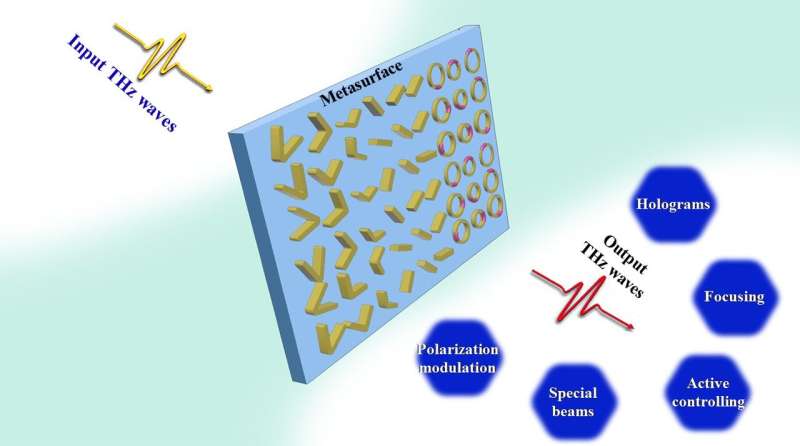The associated THz responses include focusing, holograms, polarization modulation, special beams and active controlling. Credit: Xiaofei Zang, Bingshuang Yao, Lin Chen, Jingya Xie, Xuguang Guo, Alexei V. Balakin, Alexander P. Shkurinov, and Songlin Zhuang
THz waves have a plethora of applications ranging from biomedical and medical examinations, imaging, environmental monitoring, to wireless communications, because of abundant spectral information, low photon energy, strong penetrability, and shorter wavelength. THz waves with technological advances not only determined by high-efficiency sources and detectors but also decided by a variety of high-quality THz components/functional devices. However, traditional THz devices should be thick enough to realize the desired wave-manipulating functions, hindering the development of THz integrated systems and applications. Although metamaterials have shown groundbreaking discoveries due to tunable electric permittivity and magnetic permeability of a meta-atom, they are limited by technical challenges of fabrication and high loss of the metal-based unit cell.
In a new paper published in Light: Advanced Manufacturing, a team of scientists, led by Professor Songlin Zhuang from Terahertz Technology Innovation Research Institute, University of shanghai for Science and Technology, and co-workers have summarized recent advancements of metasurfaces for the manipulation of THz waves. These ultra-compact devices with unusual functionalities render metasurface devices very attractive for applications such as imaging, encryption, information modulation and THz communications.
Actually, metasurfaces typically consist of planar antennas that enable predesigned EM responses. The antennas are made of metals or traditional high-refractive index dielectrics that can be easily fabricated based on standard fabrication processes. In addition, metasurfaces with functionality in manipulating EM waves are dependent on abrupt phase changes at planar antenna interfaces, and thus the thickness of metasurfaces is much thinner than the incident wavelength. Metasurfaces can locally control the wavefront of EM waves at subwavelength resolution, leading to various practical applications such as metalenses, waveplates, vortex beam generators, beam steering and holograms. The ultrathin nature of metasurfaces, ease of fabrication, and subwavelength resolution in manipulation of EM waves make metasurfaces ideal candidates for THz device miniaturization (ultra-compact THz devices) and system integration.
The metasurface-based approach for manipulatig THz waves enables remarkable contributions in designing ultra-thin/ultra-compact and tunable THz components. The main advantages/contributions of THz metasurfaces can be concluded as follows: (1) THz components with reduced size: The functionalities of focusing, OAM, and polarization conversion realized by metasurfaces can be traditionally obtained by using a THz lens, helical phase plate, and half-wave (or quarter-wave) plate, respectively; (2) THz components with multiple functions: The traditional THz devices, e.g. THz lenses, waveplates, etc, always show a single function. Metasurfaces not only provide a flexible platform to realize ultra-thin/ultra-compact THz devices with single function, but also enable the unprecedented capability in designing multifunctional THz devices. (3) THz components with tunable function: Metasurfaces combined with VO2, graphene, etc, open a new avenue for designing THz components with active functions.
In conclusion, metasurfaces with planar structures can locally modify the wavefront of THz waves at subwavelength resolution. Metasurfaces not only provide an ultra-compact platform for manipulating the wavefront of THz waves, but also generate a plethora of applications that are difficult to achieve with conventional functional devices. As an overview, the recent developments of metasurfaces for manipulating THz waves were presented in this paper, and this progress report may open a new avenue to design ultra-thin or ultra-compact THz functional devices and systems.
More information: Xiaofei Zang et al, Metasurfaces for manipulating terahertz waves, Light: Advanced Manufacturing (2021). DOI: 10.37188/lam.2021.010
Provided by Chinese Academy of Sciences
























